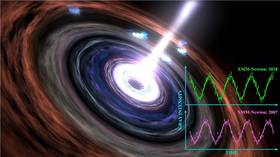ISS astronauts create FIFTH STATE OF MATTER in space for first time ever

Astronauts on board the International Space Station have created a rare state of matter in ways not possible here on Earth.
A new study published in the magazine Nature suggests that scientists have used a small facility called the Cold Atom Lab (CAL) to create rare Bose-Einstein condensates (BECs), also known as the fifth state of matter.
The CAL is capable of chilling atoms in a vacuum down to temperatures one 10-billionth of a degree above absolute zero – lower than in interstellar space. That’s why CAL – the size of a bedside table – has a reputation for being one of the coldest spots in the known universe.
BECs occur when the temperature of an ensemble of atoms almost reaches zero. These gaseous clouds of atoms then act collectively, rather than individually. First predicted by Albert Einstein and Indian mathematician and physicist Satyendra Nath Bose 95 years ago, they weren’t observed in a lab until 1995.
The reason why it was essential to make BECs in space is that, on Earth, gravity pulls them to the ground, making them disappear within fractions of a second. When created in the microgravity of space, however, BECs last longer – the atoms slow down and their wavelengths align, allowing us to study them for longer.
“It was recognized early on that microgravity would come in handy, and that going to space would give us a lot of advantages in terms of measurement time,” David Aveline, the lead author of the study and a scientist at NASA’s Jet Propulsion Lab, told Business Insider.
In the past, scientists have conducted some pretty rudimentary tests to achieve microgravity here on Earth – including using a specially constructed tower at the University of Bremen’s Center of Applied Space Technology and Microgravity, where researchers drop objects from tall heights to simulate the state.
With the CAL, BECs can be generated “amazingly quickly,” Maike Lachmann, who participated in the experiment, told German magazine Welt der Physik (World of Physics). This is because with the CAL, “you don’t have to cool large bodies, just a tiny atomic cloud,” meaning the entire process takes roughly two seconds.
Also on rt.com PHOTO: Rare sight of ISS passage against the Sun caught on cameraThe success of the CAL experiment could mark the first step in BECs becoming the basis of ultra-sensitive instruments that can detect the faintest signals from the most unknown aspects of our universe, such as gravitational waves and dark energy.
Aveline also told MIT that BECs have more practical applications, which “range from accelerometers and seismometers to gyroscopes.”
Whatever the outcome of the study, the existence of CAL means that scientists can continue to get funky with how they experiment with atoms. Watch this space.
Like this story? Share it with a friend!















